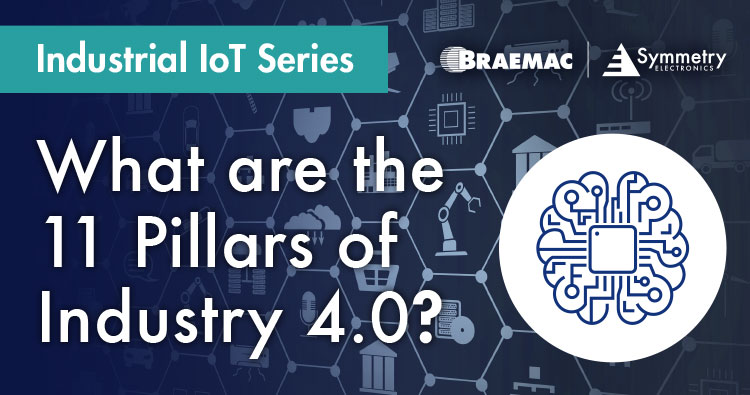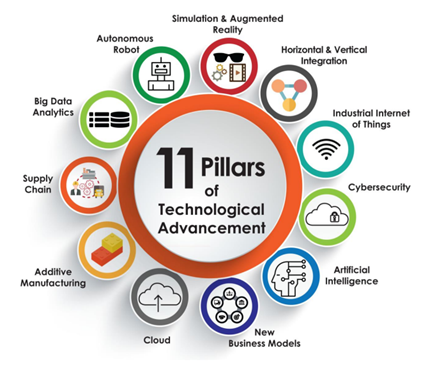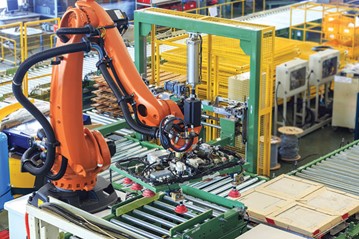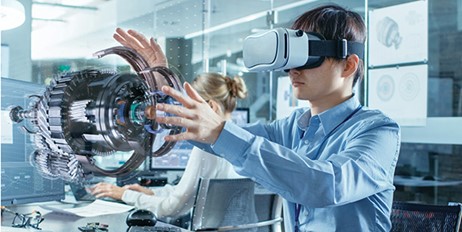- Home
- Symmetry Blog
- What are the 11 Pillars of Industry 4.0?
What are the 11 Pillars of Industry 4.0?
About Jari Haiston

Figure 1: 11 Pillars of Industry 4.0
Source: PSDC
What are the 11 Pillars of Industry 4.0?
Working in conjunction, the 11 pillars of Industry 4.0 transform the manufacturing landscape into a highly efficient, intelligent, and interconnected ecosystem. At its core, Industry 4.0 relies on the infusion of artificial intelligence (AI) to analyze vast amounts of production data, which is made accessible through the Industrial Internet of Things (IIoT). Big data analytics unlock valuable insights, while cloud computing centralizes data and facilitates seamless communication. Autonomous robots, working collaboratively with humans, execute complex tasks and feed real-time information into the system, enhancing decision-making.
Simulated and augmented reality technologies revolutionize product design and prototyping. Horizontal and vertical system integration eliminate organizational disconnects, fostering synergy. Additive manufacturing and supply chain digitization optimize production and distribution. New business models capitalize on technological advancements, and cybersecurity ensures the security of these interconnected systems. Together, these pillars empower Industry 4.0 to deliver unprecedented efficiency, productivity, and agility across the manufacturing spectrum.
The 11 pillars of Industry 4.0 are:
1. Additive Manufacturing
Technologies like 3D printers have empowered companies with the ability to rapidly prototype and produce high-performance, customized products. Additive manufacturing reduces production times and enhances product durability. Furthermore, it enables developers to incorporate intricate designs and features without increasing costs.
2. Artificial Intelligence (AI)
IBM's report, "AI Effect on Industrial Products," stated that "the average factory generates 1 terabyte of production data daily, but less than 1% of that data is actually analyzed by manufacturers." Integrating AI is the game-changer that manufacturers need to optimize production, conserve resources, and enhance services. AI systems can accumulate knowledge and analyze data spanning from raw materials to customer feedback.
3. Autonomous Robots
The integration of flexible and collaborative autonomous robots (Figure 2) extends the range of services available to manufacturers for executing complex tasks. These robots, often referred to as 'cobots,' work alongside humans and interact with other factory technologies. In the near future, cobots will have the ability to learn from human interactions.
Figure 2: An autonomous robot in a smart factory setting
Source: PneumaticTips
4. Big Data Analytics
Big data analytics play a crucial role in industry 4.0 by enabling companies to identify valuable patterns and trends. Data can be sourced from the cloud, sensors, IIoT platforms, and more. These findings empower companies with informed decision-making capabilities.
5. Cloud Computing
Utilizing hardware and software, cloud computing facilitates the transmission of messages across networks. In Industry 4.0, cloud computing offers security advantages by centralizing data storage, bandwidth, and processing. Its application programming interface (API) allows for seamless interaction between users and computers through software.
6. Cybersecurity
Maintaining secure and reliable connections is of paramount importance to safeguard smart factory information and manufacturing lines from cyber threats.
7. Horizontal and Vertical System Integration
Vertically integrated companies aim to retain most of their value chain operations in-house, while horizontally integrated companies seek to expand their value chain through external partnerships. In Industry 4.0, horizontal and vertical integration fosters seamless interconnection throughout entire organizations, eliminating disconnects between departments or suppliers.
8. Industrial Internet of Things (IIoT)
Industry 4.0 heavily relies on IIoT. Without IoT, smart systems and smart factories would not exist. IoT technology connects machines, computers, and sensors, enabling real-time communication within systems.
9. New Business Models
Industry 4.0's technological advancements offer numerous new opportunities for businesses. The potential developments in areas such as fleet telematics, asset tracking, retail environments, and more are limitless and unforeseeable.
10. Simulated and Augmented Reality
Immersive technology plays a significant role in Industry 4.0. Augmented reality (AR), distinct from other forms of virtual reality (VR), interacts with real-world environments. AR can project virtual elements into the user's surroundings. AR and simulations are revolutionizing how companies design and prototype products (Figure 3).
11. Supply Chain
Industry 4.0 marks the digitization of production flows. With Industry 4.0, transparency will create integrated ecosystems in supply chains, erasing barriers between product development, marketing, sales, and distribution.
Figure 3: Depiction of how augmented reality can enhance design processes
Source: Digital Engineering 247
What Does the Future Look Like After Full Industry 4.0 Integration?
The full integration of Industry 4.0 promises a future that is nothing short of transformative across industries. With seamless connectivity, advanced AI, and the interplay of these 11 pillars, the manufacturing landscape will become a highly intelligent and agile ecosystem. One of the most significant changes will be the emergence of truly smart factories. These factories will operate autonomously, with AI-driven decision-making, predictive maintenance, and self-optimizing processes. Human-machine collaboration, epitomized by cobots (autonomous robots), will become the norm, enhancing efficiency and safety on the factory floor.
In this future, the production process will be remarkably efficient and flexible. Additive manufacturing, facilitated by 3D printing and other advanced technologies, will allow for rapid prototyping and on-demand production of highly customized products. This not only reduces waste but also accelerates the time-to-market for new products. The supply chain will be fully digitized, allowing for real-time tracking and optimization of materials and products, ensuring minimal disruptions and maximum responsiveness to market fluctuations.
The impact of Industry 4.0 will extend beyond the factory floor. It will revolutionize customer experiences and product offerings. Companies will harness big data analytics and AI to gain profound insights into customer preferences and market trends, enabling them to deliver highly personalized products and services. Augmented reality will be a commonplace tool for product design, maintenance, and training, further enhancing user experiences. New business models will continue to emerge, driven by data-driven decision-making and innovative collaborations. Overall, the full integration of Industry 4.0 promises a future marked by unprecedented efficiency, sustainability, and innovation across all sectors of the economy.
How can Businesses Begin Their Journey into Industry 4.0?
, how can businesses embark on their journey into Industry 4.0? Embracing Industry 4.0 within their infrastructure can bring significant benefits. Autonomous robots can provide crucial information on equipment failures and reduce downtime in smart factories. With access to more transparent data, analytics, and information, factory workers will be better equipped to make informed decisions. Industry 4.0 enables optimized cost savings, performance improvements, increased productivity, and enhanced product quality. If you're interested in propelling your business into the fourth industrial revolution, contact Symmetry Electronics today!



